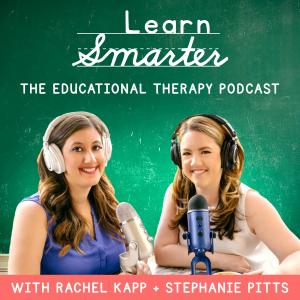Learn Smarter Podcast

Ep 02: (Executive Function Series) How to Calendar
Calendaring is hated by so many of the students we work with--and it’s the first thing we do with them. It is so critical and so important. If you do not keep track of what is going on in your life, nothing else can get done. Having a calendar is the starting point that greatly reduces anxiety in students because once you are in control of your time, you are in control of your life. You cannot get into a car and start driving unless you know where you are going--it is the same with calendaring. You cannot start reaching goals and milestones within educational therapy without knowing what they are in the first place. We encounter a lot of resistance when it comes to calendaring, but we have learned to challenge that resistance. Many students rely on online portals and memorization to keep track of their assignments and commitments. To counteract this resistance, we challenge our students to find an adult that does not have a calendar. All adults have calendars (or some sort of way of keeping track of their tasks). Like many things, it is difficult to start calendaring and there is a lot of upfront work, but as soon as the process becomes automated and habitual, you will see results. The benefits far outweigh the uncomfortable beginning of starting. One of the reasons students don’t want to calendar is because of their online portal. We have a love/hate--but mostly hate--relationship with the online portal because it teaches students learned helplessness. The online portal teaches students to rely on whattheir teachers are posting to tell them what to do everyday. Often the online portal is used differently by different teachers, sending students off on a wild goose chase to source their responsibilities. The online portal does not allow for forward planning--it is nearly impossible to manage a long-term project simply by using an online calendar. To help you and your child start calendaring we have compiled the… Seven Big Rules of Calendaring. Everything needs to be in one place. Students need to have one point of action everyday, which is, “I am going to check my calendar.” Decide AND COMMIT between digital and paper. The advantages and disadvantages of the two depend on age and preference. If you tend to lose papers but not your phone, the digital calendar may work best. We don’t want to pretend like we prefer a paper calendar--the ability to quickly automate, reconcile and access it is simply not an option with a paper calendar. Sometimes it’s unavoidable and ourclients have to use a paper calendar, but we undoubtedly prefer the digital calendar. (BONUS: You can have an all-family calendar and communicate and schedule with your child.) Automate, automate, automate. Automating is both learning smarter and working smarter. Put weekly commitments into your calendar once as a repeating event and have it always be there. Front-load. Put in all dates for all tasks as soon as you learn of them. This means, when you have the same class, every Monday at 8AM for the entire year...put that on your calendar at the beginning of the year. Layering. Digital calendars allow you to create specific calendars for the different facets of your life. We recommend that each student have two: school and personal calendars. Color code your different calendars to allow you to see how your time is being spent. Because each calendar is a different color, it allows students to visually see what is actually happening every day. The “to-do list” is an all day event. Listing your one time tasks on the same calendar as an all day event keeps everything you need in one place. Our Seven Big Rules of Calendaring are some guidelines for you to be mindful of when calendaring with your student. Now, what goes on your calendar? We have created a universal list to help guide your planning.






 Visit Podcast Website
Visit Podcast Website RSS Podcast Feed
RSS Podcast Feed Subscribe
Subscribe
 Add to MyCast
Add to MyCast